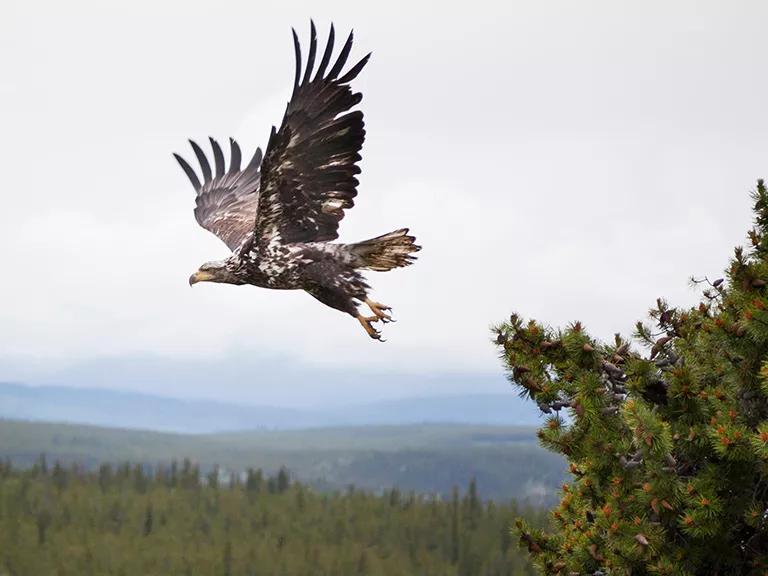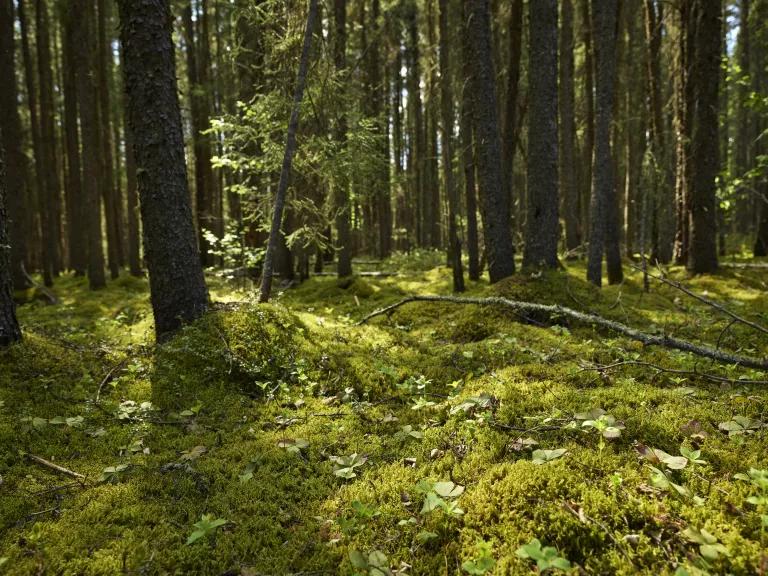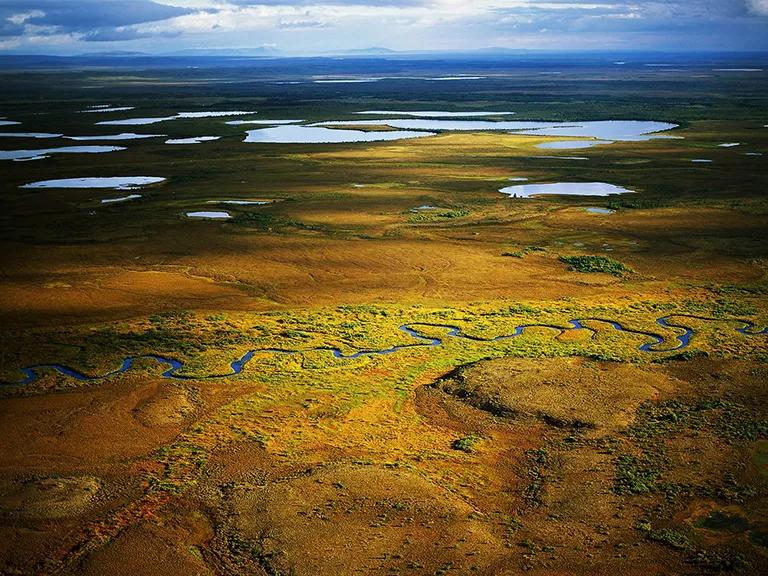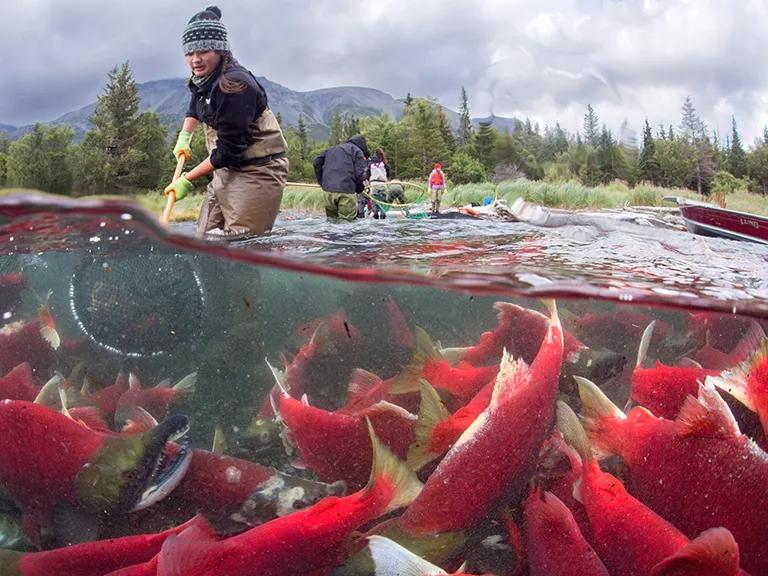Protecting the Wild
NRDC continues to advocate for protection of our wildlife, land, waters, and oceans, at home and around the world.
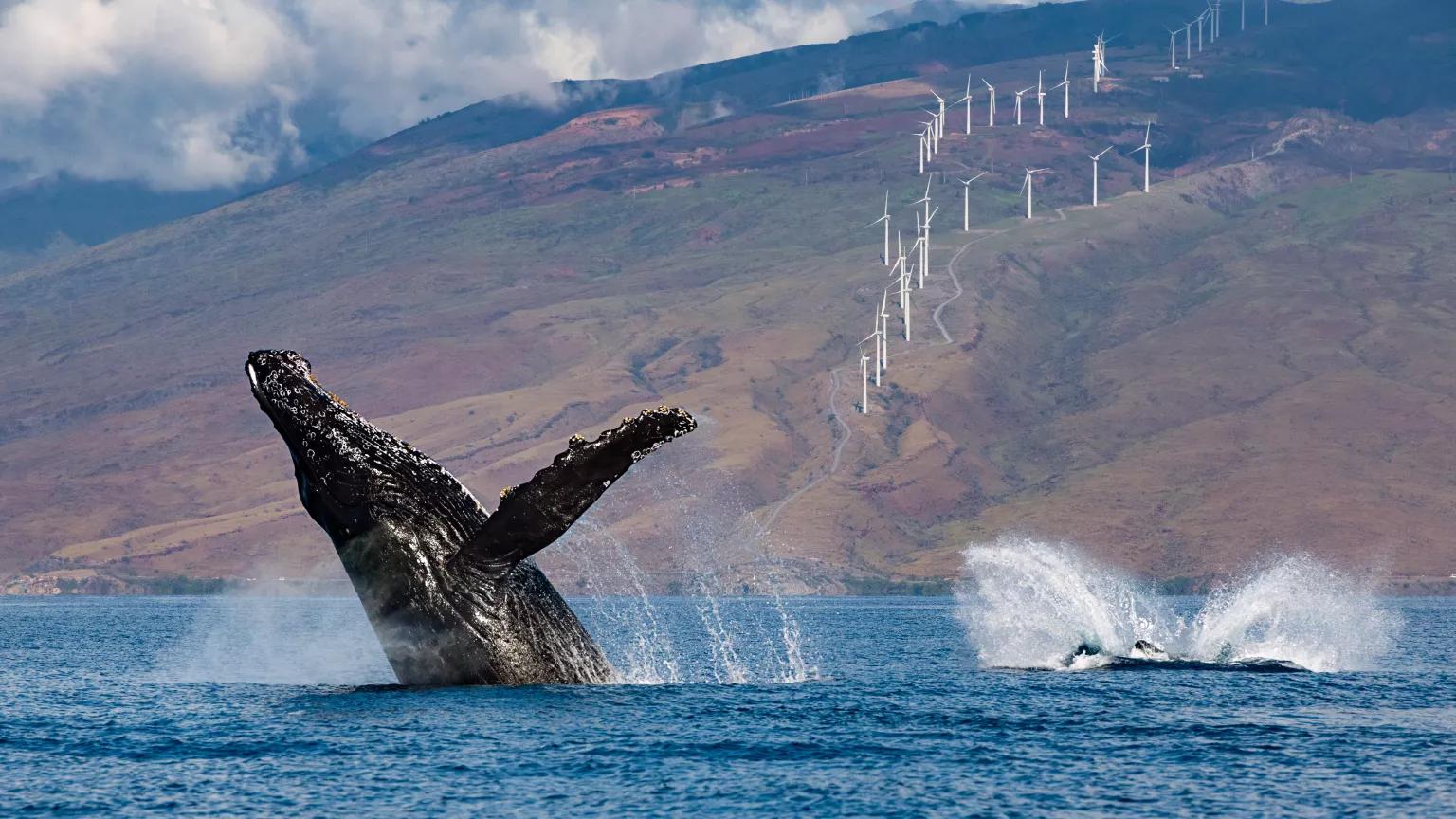
As investments in offshore wind continue to grow, this new industry must provide smart protections to ensure the safety of marine mammals.
© Doug Perrine/naturepl.com
As human development, habitat loss, and climate change continue to reshape the planet’s ecosystems, wildlife and their habitats are under increasing threat. And their fates are tied to our own: Human lives, after all, are intrinsically connected with the health of the environment. In collaboration with local communities and Indigenous Peoples, NRDC has maintained our focus on defending keystone species from extinction, advancing national and global commitments to protect climate-critical landscapes and seascapes at risk, overcoming barriers that prevent equitable access to nature, and fighting against dirty industries that are exploiting the natural resources that sustain us all.
Defending Keystone Species
Apex predators like gray wolves play a significant role in sustaining the health of their ecosystems. Wolves are also culturally significant to many Indigenous groups. Recognizing the importance of these animals, NRDC has been working diligently to restore federal protections for the gray wolf under the Endangered Species Act (ESA) ever since the U.S. Fish & Wildlife Service (USFWS) finalized a rule that eliminated those protections in November 2020. The iconic canine was first listed under the ESA nearly 50 years ago and we have seen great strides in the population’s recovery since then.
Despite those gains, however, gray wolves are still facing threats throughout much of their range. Under the Trump administration, USFWS considered the number of wolves in the Great Lakes region alone as enough to sustain the species as a whole across all the areas it was listed throughout the country. In response, we took the agency to court in January 2021, arguing that the limited recovery of that single population did not merit delisting wolves. Thankfully, a U.S. district court agreed, and we came out victorious in February 2022 when a federal judge restored protections for gray wolves under the ESA across 44 states.
In addition to our successful lawsuit, our wildlife advocates have continued to press for greater gray wolf protections in the Northern Rockies, where they remain unlisted and subject to aggressive state policies. Throughout the region, NRDC is also collaborating with the U.S. Department of Agriculture’s Wildlife Services agency on strategies to help ranchers better protect their livestock. Preventing wolf predation on livestock through the use of fencing and other nonlethal tools can help keep wolves out of trouble. Additionally, we continue to push for a national recovery plan that will help wolves fully recover across the country, to the point where ESA protections would no longer be necessary.
Some of our most recent conservation victories were more than a decade in the making. In December, our Nature program celebrated a decision by USFWS to finally list the whitebark pine, a wide-ranging species of tree found on mountaintops in much of western North America, under the ESA. The decision was made in response to NRDC’s 2008 petition to the agency; at that time, studies showed 80 percent of whitebark pine forests in the Greater Yellowstone Ecosystem to be either dead or dying. “Whitebark pine is the first widely distributed tree that the federal government has clearly pegged as a climate casualty,” says Sylvia Fallon, a senior director of NRDC’s Science Office, who helped author the initial ESA petition. “Sadly, as climate change worsens, it will not be the last.” It’s a message that NRDC has continued to underscore with decision makers at every level as we face a deepening biodiversity crisis the world over.
“Humanity must tackle the climate and biodiversity crises together if we want to effectively address either.”
Zak Smith, senior attorney & director, global biodiversity conversation, Nature Program
Our wildlife policy experts are also helping to shape conservation efforts in the ocean. In June, NRDC and partners signed an agreement with South Fork Wind, a joint venture developed by Ørsted and Eversource off the coast of New York. The agreement incorporated measures that further safeguard the health of the critically endangered North Atlantic right whale, which shares these waters. Mitigation measures include stronger monitoring to make sure the whales are not nearby during the facility’s noisy construction activities and adopting a 10-knot speed limit for all project-related vessels in right whale habitat to prevent collisions with these animals.
With fewer than 340 remaining as of 2021, North Atlantic right whales are among the most endangered whales on the planet. Threats include vessel strikes and fishing gear entanglements, underwater noise pollution, malnourishment, and the difficulties of adapting to the impacts of climate change. While the right whale crisis is not a problem caused by the offshore wind industry, it is one the new industry must face because the species is simply unable to withstand more loss or disturbance. Smart protections like those provided in the agreement show that we don’t need to choose between clean energy development and wildlife protection. As New York State’s first offshore wind farm, South Fork Wind is set to generate enough power for approximately 70,000 homes once it begins operations in late 2023.
Did You Know?
The Intergovernmental Panel on Climate Change (IPCC) reported a dozen natural systems—including ice sheets in Antarctica and Greenland, the Amazon rainforest, and the Canadian boreal forest—that are at risk of “tipping” over a critical, irreversible threshold. Once we hit those tipping points, these ecosystems will become unstable and shift into dramatically different states.
Advancing 30x30
Momentum is growing in the movement to protect at least 30 percent of our lands, rivers, lakes, wetlands, and oceans by 2030. Our nature experts made this target a priority heading into the 15th Conference of the Parties (COP15) to the Convention on Biological Diversity in December, where delegates met to agree upon global conservation goals for the next decade. Working with coalition partners and leadership governments, including Nigeria and Panama, we successfully fought for a global 30x30 target and the inclusion of language to ensure that land and ocean areas receive the quality protection they deserve. And during the conference, we supported the final adoption of a commitment to ensure biodiverse, lower-income nations can pay for these efforts. Specifically, funding for conservation will now increase to at least $200 billion annually by 2030, with $20 to $30 billion going directly to lower-income countries.
Still, the battle for nature remains an uphill one. Indeed, many of the very areas that governments would turn to first to help them meet 30x30 goals are now increasingly subject to clearcutting for the harmful biomass industry. Under particular threat are primary forests like Canada’s boreal, ancient forests like those in Romania, areas protected as habitat for imperiled birds like in Estonia, and wetlands and peatlands all over the world. NRDC has sought to expose this dirty source of energy for what it is—treating our forests as fuel—and commissioned a recent report showing that just 10 European countries subsidize biomass energy with a whopping €6.3 billion every year.
Of course, global treaties must also be complemented by action on a local level. That’s why our California policy experts are supporting efforts by Governor Gavin Newsom to advance the state’s own 30x30 initiative. California is off to a strong start, but must do more to protect ecosystems and halt the biodiversity crisis. California’s unique coastal and marine habitats have been under constant threat from climate change and habitat loss, with destructive practices by the fishing industry being partly to blame. As a result, we have seen drastic declines in tidal marshes, kelp forests, and eelgrass beds—all of which contribute to the stability of the local ecologies and biodiversity. In July, NRDC released a set of policy recommendations in order for the state to successfully reach its 30x30 commitment. The guidelines emphasize the importance of creating, strengthening, and expanding Marine Protected Areas, which act as safe havens where ocean life can rebound from environmental stressors.
Human well-being, too, depends on protecting our coastal ecosystems—even beyond the tangible benefits we get from the sea’s bounty and the ocean’s role in regulating our climate. A healthy shoreline also nurtures our spirits. Yet unfortunately, the simple act of getting to the coast is often an insurmountable hurdle for inland communities, particularly BIPOC communities, who face numerous barriers to accessing beaches, parks, and other outdoor spaces. California’s 30x30 commitment aims to address this inequity directly. Our policy recommendations included several tactics to support access for communities of color, such as creating an ocean equity advisory panel, establishing programs to facilitate outreach to and education for underserved communities, and ensuring at least 50 percent of implementation funding goes toward equity programs.
Keeping Industry Out of Precious Lands & Seascapes
The fight to protect Bristol Bay, Alaska, from destructive mining and development goes back decades. Over the past 12 years, it’s united an exceptionally diverse coalition that includes members of Indigenous communities, commercial and recreational fishers, hunters, businesses, faith leaders, and nonprofit organizations like NRDC, all determined to preserve the world’s largest sockeye salmon fishery and the communities and cultural traditions it sustains. In December, our alliance hit a monumental milestone when the U.S. Environmental Protection Agency (EPA) released a recommendation under the Clean Water Act that would prohibit the Pebble Mine and restrict future mining of certain headwaters in Bristol Bay. The determination was subseqeuntly finalized in January—a landmark conservation victory that puts an end to the destructive copper and gold mine project and provides lasting protections for the watershed.
Our longtime Bristol Bay advocates Taryn Kiekow Heimer and Joel Reynolds worked tirelessly to drive broad-based participation during the public comment period that helped pave the way for the agency’s decision. In addition to mobilizing thousands of our members and activists, who submitted letters to help shut down the Pebble Mine, we backed the United Tribes of Bristol Bay in its grassroots efforts to generate public engagement in support of EPA action and organized a group sign-on letter that more than 120 international, national, state, and local groups joined on behalf of their 10 million–plus members. The efforts paid off: More than half a million individual comments—including from a record 30,000 Alaskans with 2,500 Bristol Bay residents among them—were submitted to the agency. Yet, despite the singular importance of the EPA’s decision, we understand that vetoing the Pebble Mine is not the end of the road, and that the fight for Bristol Bay will go on. As Reynolds reminds us, “the need for vigilance remains.”
In another significant stand against corporate irresponsibility, investors at a Home Depot shareholders’ meeting overwhelmingly voted to approve a resolution that calls on the company—the world’s largest home improvement retailer—to issue a report assessing how its supply chains contribute to deforestation and the degradation of primary forests. This vote marked just the second time ever that a forest-related shareholder resolution passed over board opposition.
The Wood Purchasing Policy at Home Depot has remained unchanged for the last 20 years, leaving it critically lagging on sustainability and human rights standards. Its policy has no guardrails in place to avoid sourcing its building materials from irreplaceable primary forests, including those in the climate-critical boreal forest. With the support of our partners, we led the development of written and oral briefings to investors outlining the deficiencies in the company’s sourcing and the reputational, marketplace, and regulatory risks they pose. Consumers, too, will increasingly expect more accountability from corporations like Home Depot to protect our planet’s future and conduct business sustainably. “This investor vote is not just a reproach to Home Depot’s leadership, but a signal to the entire marketplace that companies’ abrogation of forest and human rights standards is not just an environmental liability but a financial one,” said NRDC’s Jennifer Skene, natural climate solutions policy manager.
More 2022 Highlights
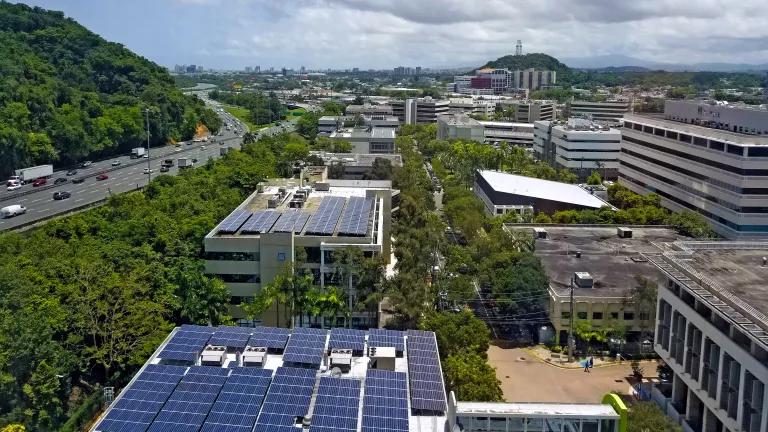
Standing with Communities

Fighting for Our Climate Future

Defending Public Health
Annual Report 2022: A Turning Point
Explore the rest of our annual report for an overview of what we've accomplished in 2022.




